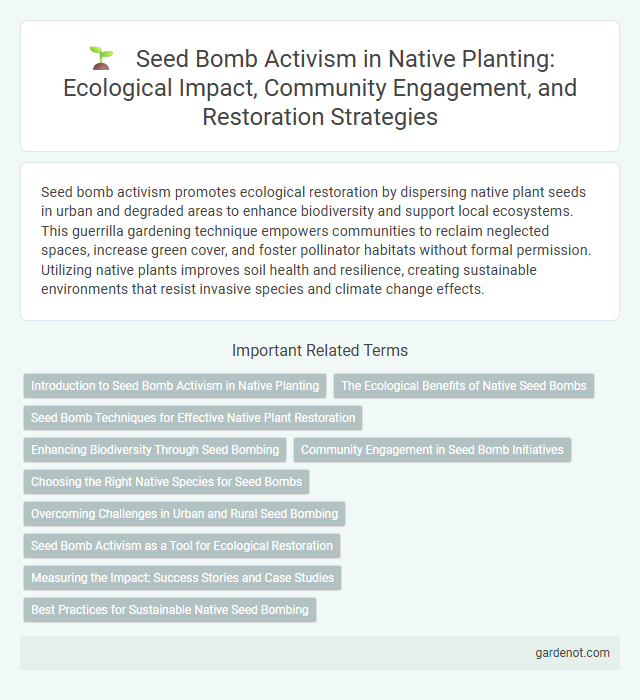Seed bomb activism promotes ecological restoration by dispersing native plant seeds in urban and degraded areas to enhance biodiversity and support local ecosystems. This guerrilla gardening technique empowers communities to reclaim neglected spaces, increase green cover, and foster pollinator habitats without formal permission. Utilizing native plants improves soil health and resilience, creating sustainable environments that resist invasive species and climate change effects.
Introduction to Seed Bomb Activism in Native Planting
Seed bomb activism in native planting merges ecological restoration with grassroots activism by dispersing compressed seed clusters containing indigenous plant species. This method revitalizes degraded landscapes, enhances biodiversity, and fosters community engagement in conservation efforts. Utilizing seed bombs accelerates reforestation and habitat creation, promoting resilience in native ecosystems.
The Ecological Benefits of Native Seed Bombs
Native seed bombs enhance biodiversity by dispersing indigenous plant species that restore natural habitats, support pollinators, and improve soil health. These seed bombs promote ecosystem resilience by re-establishing native flora, which helps control erosion and provides food and shelter for local wildlife. Using native seed bombs reduces invasive species proliferation and strengthens ecological balance in urban and degraded environments.
Seed Bomb Techniques for Effective Native Plant Restoration
Seed bomb techniques for native plant restoration involve encasing native seeds in nutrient-rich clay and compost pellets, which protect seeds from birds and harsh weather while promoting germination. This simple, low-cost method enables effective reintroduction of native flora into degraded landscapes, enhancing biodiversity and ecosystem resilience. Strategic placement of seed bombs in targeted areas maximizes seed dispersal and supports natural regeneration without the need for intensive labor or machinery.
Enhancing Biodiversity Through Seed Bombing
Seed bomb activism enhances biodiversity by dispersing native plant seeds across degraded urban and rural landscapes, promoting the growth of diverse flora. This method increases habitat complexity, supports pollinator populations, and restores ecological balance in areas affected by human activity. Native seed bombs deliver resilient plant species that improve soil health, foster wildlife habitats, and strengthen local ecosystems naturally.
Community Engagement in Seed Bomb Initiatives
Seed bomb activism fosters community engagement by empowering local residents to revitalize urban green spaces through native planting. Collaborative workshops and seed bomb-making events enhance environmental awareness and create social bonds among participants. These initiatives promote biodiversity, strengthen ecological resilience, and encourage sustainable stewardship of local habitats.
Choosing the Right Native Species for Seed Bombs
Selecting the right native species for seed bombs ensures higher germination rates and supports local biodiversity. Prioritize hardy, drought-resistant plants that thrive in the specific soil and climate conditions of the target area. Incorporating wildflowers, grasses, and shrubs native to the region maximizes ecological benefits and aids in habitat restoration.
Overcoming Challenges in Urban and Rural Seed Bombing
Seed bomb activism transforms urban and rural landscapes by reintroducing native plants through lightweight, nutrient-rich seed capsules designed for easy dispersal in challenging environments. Overcoming obstacles such as compacted soil, pollution, and limited green spaces requires strategic seed selection and timing to enhance germination and growth success rates. This method fosters biodiversity, improves soil health, and supports local ecosystems by promoting the natural regeneration of indigenous flora.
Seed Bomb Activism as a Tool for Ecological Restoration
Seed bomb activism serves as a dynamic tool for ecological restoration by dispersing native plant seeds in degraded urban and rural landscapes, facilitating natural regeneration without extensive labor or resources. This guerrilla gardening technique enhances biodiversity, improves soil health, and combats habitat loss by reintroducing indigenous flora in areas affected by deforestation or urbanization. By empowering communities to participate in seed bombing, this approach fosters environmental stewardship and accelerates the recovery of native ecosystems.
Measuring the Impact: Success Stories and Case Studies
Seed bomb activism has transformed urban landscapes by promoting native planting through innovative guerrilla gardening techniques. Case studies from cities like Detroit and Los Angeles demonstrate measurable improvements in biodiversity, soil health, and community engagement, with reports indicating up to a 30% increase in native plant coverage. Success stories highlight how seed bomb projects restore ecosystems, support pollinators, and foster environmental stewardship in underserved neighborhoods.
Best Practices for Sustainable Native Seed Bombing
Seed bomb activism promotes ecological restoration by dispersing native seeds through biodegradable seed bombs designed for minimal environmental impact. Best practices for sustainable native seed bombing include sourcing locally adapted seeds to enhance biodiversity, ensuring seed mix diversity to support various pollinators, and selecting planting sites with suitable soil conditions and minimal invasive species competition. Using organic materials for the seed bombs and monitoring post-dispersal growth improves germination rates and long-term habitat resilience.
Seed bomb activism Infographic

 gardenot.com
gardenot.com